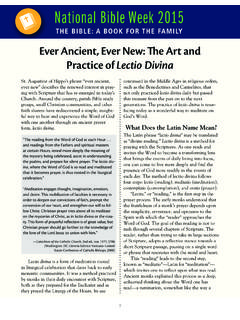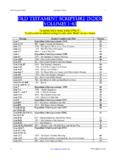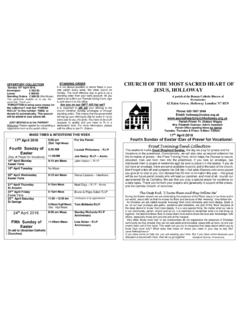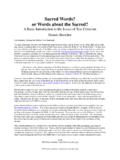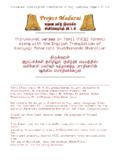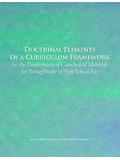Transcription of The Senses of Scripture - United States Conference of ...
1 The Senses of Scripture by Pauline A. Viviano, PhD. T. he Church has a rich tradition of interpreting sacred alone can any argument be drawn, and not from those Scripture . That tradition had begun already in the intended in allegory. 4 This importance was reiterated in New Testament, as the Old Testament was inter- Pope Pius XII's exhortation to Catholic biblical scholars: preted in relationship to Christ, and it was further devel- let the Catholic exegete undertake the task, of all those oped by the early Church Fathers and systematized in the imposed on him the greatest, that namely of discovering medieval period. Though modern and contemporary biblical and expounding the genuine meaning of the sacred Books. scholarship both have adopted new means and new aids to In the performance of this task let the interpreters bear in exegesis 1 as encouraged by Pope Pius XII, the foundation mind that their foremost and greatest endeavor should be laid by the early Church Fathers and the medieval Church to discern and define clearly that sense of the biblical words continues to support subsequent inquiries into the mean- which is called literal.
2 5. ing of the biblical text. The early Church Fathers were not bound to one meaning of the text but rather allowed the The spiritual sense refers to when what is signified by biblical text to speak its message in various ways. These the words of a text, the literal sense, also has a further various ways correspond to the levels of meaning in a text; As it developed within Christianity, the these levels of meaning we call the Senses of Scripture . spiritual sense pertained to the meaning expressed by the biblical texts when read under the influence of the Holy There are two basic Senses of Scripture : the literal sense and Spirit, in the context of the paschal mystery of Christ and the spiritual sense. The literal sense refers to the sense of of the new life which flows from it. 7 Spiritual interpretation the words themselves; it is that which has been expressed of the Old Testament was especially prominent for the directly by the inspired human authors.
3 2 It has been Church Fathers, for the Old Testament was believed to variously described as the verbal or grammatical sense, the contain God's preparation for his Son. The early Church plain sense, the sense the human author intended, the sense Fathers used many terms to refer to the spiritual meaning the divine author intended, the historical sense, and even of the text, such as allegorical sense, mystery or mystical the obvious sense. Underlying these various descriptions is sense, and The lines between these various terms the notion that the literal sense is the meaning conveyed are blurred, and their meanings often overlap. Indeed, at by the words of Scripture . 3 The literal sense is discovered times these terms were used interchangeably by the early by careful and attentive study of the biblical text using Church Fathers. all interpretive tools available, such as grammatical aids, archaeological evidence, historical and literary analyses, By the medieval period, three distinct spiritual Senses sociological and anthropological studies, and whatever emerged: the allegorical sense (which included typology), else can be called upon to expand one's knowledge of the the tropological or moral sense, and the anagogic or historical and literary context of the text and thereby gain a future sense.
4 Better understanding of the literal sense of the biblical text. The importance of the literal sense was long ago underscored by St. Thomas Aquinas in his recognition that 4 St. Thomas Aquinas, Summa Theologiae, trans. English Dominicans all the Senses are founded on one the literal from which (New York: Christian Classics, 1981), I, 1, 10, ad. 1. 5 Pope Pius XII, Divino Af ante Spiritu, no. 23. 6 St. Thomas Aquinas, Summa Theologiae, I, 1, 10. 1 Pope Pius XII, Divino Af ante Spiritu (1943), no. 33, trans. National 7 Pontifical Biblical Commission, The Interpretation of the Bible in the Catholic Welfare Conference , in The Bible Documents: A Parish Church, no. 135. Resource (Chicago: Liturgy Training Publications, 2001), 22. 8 From Raymond Brown, The Sensus Plenior of sacred Scripture 2 Pontifical Biblical Commission, The Interpretation of the Bible in the (Baltimore, MD: St. Mary's University, 1955), 46: Sometimes theoria Church (1993), no.
5 131, in The Bible Documents, 162. is used in the same sense as allegory, but in the Antiochene school 3 Catechism of the Catholic Church (2nd ed.) (Washington, DC: it specifically refers to the perception of the future which a prophet Libreria Editrice Vaticana United States Conference of Catholic enjoys through the medium of the present circumstances which he is Bishops, 2000), no. 116. describing.. 1. The allegorical sense refers to the meaning that is hidden the Jerusalem above is freeborn, and she is our beneath the surface of the text. The search for the mother. (Gal 4:22-26). allegorical meaning of texts finds its origin in the Greek world, especially in Platonic philosophy as it was understood The allegorical method of interpretation dominated in the in the Hellenistic period. Allegorical interpretation was early Church from the time of Clement of Alexandria (150. employed to make sense of the Greek myths in which the to 211/215 CE) through the fourth century.
6 Origen, living gods often appeared crude and their behavior immoral. in the 3rd century CE, is perhaps the greatest representative Underlying the allegorical method is the notion that the of this kind of interpretation. writers of an earlier age composed their works in a veiled language. They wrote one thing but intended another. Though today scholars make a distinction between In order to hold on to the stories of old, and yet to allow allegorical and typological interpretation, such a distinction these stories to speak to a new age, it is necessary to find was not made in the early Church. The early Church a meaning beyond what the written word said. In order Fathers spoke of types, but they did not distinguish to uncover the true meaning of those ancient myths, it is between allegory and typology as scholars have recently necessary to treat the written word as a symbol for a deeper begun to do. What is distinctive to typology is the notion reality; it is necessary to find a deeper meaning below that what preceded Christ was but a shadow of what the surface or literal meaning of the text.
7 By means of was to come. Persons and events of the Old Testament allegorical interpretation, truth is unveiled; where there was are understood to be types of persons or events in the mystery now stands revelation. New Testament, which are then antitypes. The Old Testament, interpreted typologically, is said to anticipate Like the ancient Greek myths, many passages in the or to foreshadow events to come. The crossing of the Red Jewish Scriptures are obscure or seemingly inconsistent, or Sea is seen as a type of Baptism; Isaac carrying the wood for the content of the passage is seen as unacceptable when his sacrifice in Genesis 22 is seen as a type of Jesus' carrying judged by the standards of a later age. Use of the allegorical his cross to Calvary. Some representatives of typological method to interpret the Bible in the early Church could interpretation are Diodorus of Tarsus, St. John Chrysostom, explain away its inconsistencies, the questionable behavior and Theodore of Mopsuestia.
8 Typology is found in the of its characters, and its crudeness. The greatest proponent exegetical work of St. Augustine and St. Jerome alongside of allegorical method of interpretation of the Jewish allegorical interpretation. Scriptures was Philo of Alexandria. In his search for the deeper significance of the text, Philo identified biblical Allegorical interpretation gave the early exegetes a way characters with abstract virtues or with the soul in its to find meaning in the Bible, including its obscure and journey through life. Names, numbers, measurements, and unseemly passages; but because of this method's focus on seemingly mundane details were explored for their hidden the deeper spiritual meaning of a text, the literal sense meaning and given cosmic or mystical The became viewed as insignificant. Typological interpretation, allegorical method of Philo of Alexandria was influential in by contrast, maintained a greater respect for the literal the development of Christian allegorical interpretation.
9 Sense because this method of interpretation is more firmly grounded in the literal sense of the text. Both typology Allegorical interpretation is already found in the New and allegory, however, went beyond the literal sense of the Testament. For example, Paul in the Epistle to the text in the early Church. For typologists the written word Galatians says, pointed beyond itself; for allegorists the written word stood for something else. For it is written that Abraham had two sons, one by the slave woman and the other by a freeborn The other two spiritual Senses , the tropological sense and woman. The son of the slave woman was born the anagogic sense, are defined in terms of their focus. The naturally, the son of the freeborn through a tropological sense is concerned with the moral lessons that promise. Now this is an allegory. These women can be drawn from the biblical text. If events in Israel's past are two covenants. One was from Mount Sinai, were written down to instruct us (1 Cor 10:11), then we bearing children for slavery; this is Hagar.
10 But can learn how we ought to live by paying careful attention to the history of Israel, the words of the prophets, and the exhortations found in Israel's wisdom traditions indeed, to the entire Bible. The anagogic sense represents a shift 9 James L. Kugel, Early Biblical Interpretation (Philadelphia: in focus to the future, specifically to the end times or last Westminster Press, 1986), 82. 2. things. It looks to the goal of our journey through life as we was enthroned as the ultimate criterion of knowledge, are led up 10 to our heavenly home. and interpretive methods began to change. Authority and tradition were called into question, and scientific method The fourfold Senses of Scripture the literal, allegorical, began to dominate all fields of inquiry. The explosion of moral (tropological), and anagogic Senses were first knowledge that accompanied the emergence of science, proposed by John Cassian (ca. 360-435). By way of example, coupled with archaeological discoveries, raised critical Cassian wrote, The one Jerusalem can be understood in questions about the factual and scientific accuracy of four different ways, in the historical sense as the city of the the Bible.
